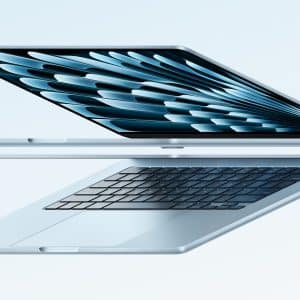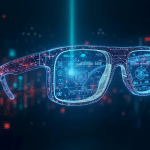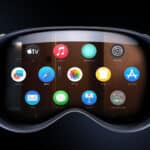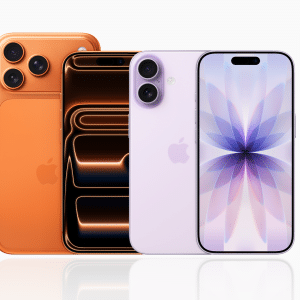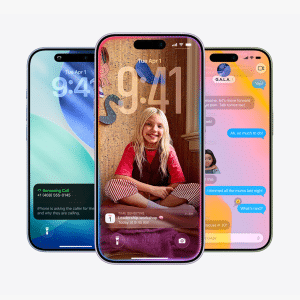The first-generation Vision Pro marked Apple’s bold entry into the AR/VR market. With its advanced optics, powerful M-series chips, and seamless integration with the Apple ecosystem, the Vision Pro set a new standard for mixed-reality devices. Its immersive experience, combined with Apple’s focus on design and functionality, has made it a standout in the market.
Key Features of the First-Gen Vision Pro
- Advanced Optics and Display Technology: The Vision Pro features high-resolution displays and advanced optics, offering a sharp and immersive visual experience.
- Powerful Performance: Powered by Apple’s M-series chips, the Vision Pro delivers the processing power needed for demanding AR/VR applications.
- Seamless Integration: The device works effortlessly with other Apple products, enhancing productivity and entertainment experiences.
What to Expect from the Second-Generation Vision Pro
The second-generation Vision Pro is expected to feature even more advanced display technology, with improvements in resolution, brightness, and refresh rates. These enhancements will provide users with a more immersive and lifelike AR/VR experience, making the Vision Pro a leader in the field.
Battery life is a critical factor for any wearable device. The second-gen Vision Pro is likely to offer longer battery life, allowing users to engage in extended sessions without interruption. Additionally, improvements in design and materials could make the device more lightweight and portable, increasing its appeal for both casual and professional users.
Apple is expected to integrate more sophisticated sensors and tracking capabilities into the second-gen Vision Pro. These advancements will improve the accuracy of hand and eye tracking, enhancing the overall user experience and enabling more intuitive interactions within AR/VR environments.
As the Vision Pro ecosystem grows, we can expect a broader range of applications and experiences tailored for the device. Apple’s continued investment in ARKit and collaboration with developers will likely lead to innovative apps that fully exploit Vision Pro’s capabilities.
The Emergence of Apple’s New Smart Glasses
In addition to the Vision Pro, Apple is reportedly working on a new pair of smart glasses. These glasses are expected to focus on lightweight AR experiences, catering to everyday users who want to incorporate AR into their daily lives without the bulk of a full-fledged headset.
Key Features of the Smart Glasses
- Subtle Design: Unlike the Vision Pro, these smart glasses are likely to feature a more discreet design, resembling traditional eyewear rather than a tech device.
- Lightweight AR Integration: The smart glasses will likely offer basic AR features, such as overlaying information on the real world, navigation, and notifications.
- Seamless Connectivity: As with all Apple products, these glasses will integrate seamlessly with the Apple ecosystem, allowing users to access apps, messages, and more directly from their eyewear.
While the Vision Pro targets tech enthusiasts and professionals who need powerful AR/VR capabilities, the smart glasses will cater to a broader audience. They will likely appeal to users who are interested in AR but prefer a more lightweight, everyday solution.
As Apple continues to innovate in the AR/VR space, it will face competition from established players like Meta (formerly Oculus) and emerging startups. Apple’s ability to differentiate its products through superior design, functionality, and ecosystem integration will be crucial for maintaining its market leadership.
One of the significant challenges for Apple’s AR/VR devices is user adoption, particularly concerning price sensitivity. The Vision Pro is positioned as a premium product, which could limit its appeal to a niche market. The smart glasses, on the other hand, will need to strike a balance between advanced features and affordability to attract a broader audience.
With the integration of advanced sensors and AR capabilities, privacy and security will be paramount. Apple will need to address concerns related to data collection and ensure that user information is protected across its AR/VR devices.
The Future of AR/VR with Apple
Apple’s continued investment in AR/VR technology is likely to drive innovation across the tech industry. As Apple sets new standards with the Vision Pro and smart glasses, other companies will be compelled to innovate and compete, leading to rapid advancements in AR/VR technology.
The implications of Apple’s AR/VR devices extend beyond consumer entertainment. Industries such as healthcare, education, and retail could benefit from the immersive experiences and enhanced productivity tools that these devices offer. For example, AR could revolutionize medical training, while VR could provide new ways for students to engage with educational content.
As AR/VR technology evolves, it may usher in a new era of computing where digital and physical realities merge seamlessly. Apple’s Vision Pro and smart glasses could be at the forefront of this transformation, changing how we interact with technology and the world around us.
The second-generation Vision Pro and Apple’s upcoming smart glasses represent the next steps in the evolution of AR/VR technology.


